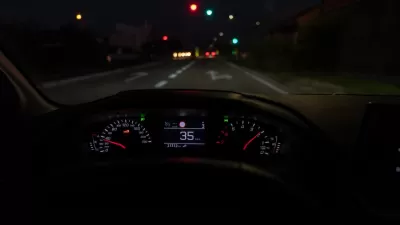Better Cities & Towns gives its imprimatur to the "narrower is better" approach to lane width for traffic safety thanks to a study by Toronto transportation planner, Dewan Masud Karim, presented at the Canadian ITE annual conference.

"Another study recently published supports 10-foot travel lanes over the 12-foot common practice on medium- and high-volume urban thoroughfares," writes Robert Steuteville, editor and executive director of Better Cities & Towns. "Planner and Walkable City author Jeff Speck wrote an article [posted here] last fall stating that state DOTs and county road commissions 'have blood on their hands' for building over-wide lanes in urban areas."
"The evidence cited by Speck on the safety hazards of wider lanes is powerful, though to date it remains pretty scarce," writes Eric Jaffe in CityLab. The evidence just got thicker thanks to Dewan Masud Karim, a senior transportation planner in Toronto and adjunct lecturer at Metro College of Technology, Toronto.
Karim looked at lanes in Toronto and Tokyo, specifically at crash data associated at randomly chosen intersections. He "found that collision rates escalate as lane widths exceed about 10.5 feet," wrote Planetizen blogger Todd Litman on the study in June, prior to its presentation to the Canadian Institute of Transportation Engineers' annual conference.
Steuteville adds that "Chris McCahill of the State Smart Transportation Initiative summarizes the new study in this way:"
Side impact- and turn-related crash rates are lowest at intersections where average lane widths are between 10 and 10.5 feet...This challenges the long-held, but often disputed, assumption that wider lanes are safer.
According to a 2010 study published in the ITE Journal, six states require a minimum of 12-foot lanes and another 24 states require 11-foot lanes.
"The latest research clearly shows that 10-foot lanes are worth fighting for on major urban thoroughfares," concludes Steuteville.
Toronto has since embarked on a program to narrow lane widths, in part due to Speck's earlier work, notes Planetizen managing editor James Brasuell.
Hat tip: Len Conly, Sierra Club Green Transportation listserv.
FULL STORY: Over-wide streets? You may regret it

Alabama: Trump Terminates Settlements for Black Communities Harmed By Raw Sewage
Trump deemed the landmark civil rights agreement “illegal DEI and environmental justice policy.”

Planetizen Federal Action Tracker
A weekly monitor of how Trump’s orders and actions are impacting planners and planning in America.

The 120 Year Old Tiny Home Villages That Sheltered San Francisco’s Earthquake Refugees
More than a century ago, San Francisco mobilized to house thousands of residents displaced by the 1906 earthquake. Could their strategy offer a model for the present?

Ken Jennings Launches Transit Web Series
The Jeopardy champ wants you to ride public transit.

BLM To Rescind Public Lands Rule
The change will downgrade conservation, once again putting federal land at risk for mining and other extractive uses.

Indy Neighborhood Group Builds Temporary Multi-Use Path
Community members, aided in part by funding from the city, repurposed a vehicle lane to create a protected bike and pedestrian path for the summer season.
Urban Design for Planners 1: Software Tools
This six-course series explores essential urban design concepts using open source software and equips planners with the tools they need to participate fully in the urban design process.
Planning for Universal Design
Learn the tools for implementing Universal Design in planning regulations.
Clanton & Associates, Inc.
Jessamine County Fiscal Court
Institute for Housing and Urban Development Studies (IHS)
City of Grandview
Harvard GSD Executive Education
Toledo-Lucas County Plan Commissions
Salt Lake City
NYU Wagner Graduate School of Public Service




























